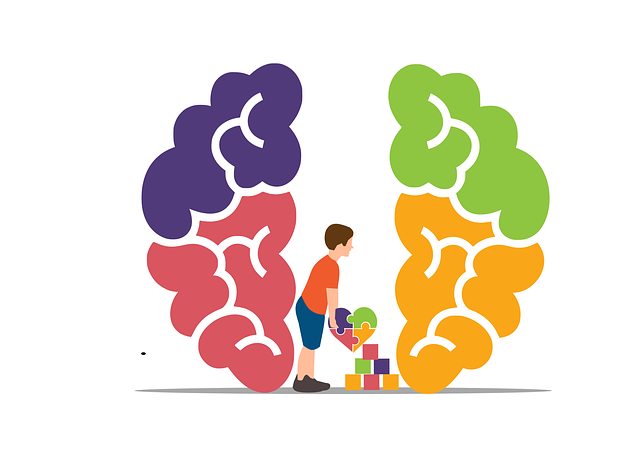Understanding mental health data through employee self-reports, organizational surveys, clinical assessments, and social media interactions is key to addressing Greenwood Village workplace issues and job stress. Analyzing trends helps organizations identify well-being challenges like burnout, anxiety, or depression, leading to targeted interventions like Social Skills Training and Stress Management Workshops. A proactive approach enhances employee resilience, improves mental health outcomes, and promotes a healthier, more productive work environment. Data-driven strategies tailored to Greenwood Village communities focus on root causes of mental health issues, with programs designed for professionals and community outreach. Effective implementation requires collaboration between HR, wellness coordinators, and mental health professionals while maintaining ethical data collection and employee privacy. Regular evaluation ensures strategies remain relevant and effective in meeting evolving needs.
Mental health data analysis is a powerful tool for understanding and addressing workplace stress, as evidenced by the unique case study of Greenwood Village. This article explores the intricate process of analyzing and interpreting mental health data, specifically focusing on identifying patterns in Greenwood Village’s workforce.
We’ll delve into where to find such data, how to analyze it to uncover hidden trends related to job stress, and practical strategies for using these insights to implement effective therapy interventions within the workplace setting.
- Understanding Mental Health Data: Collection and Sources
- Analyzing Greenwood Village Workplace Issues and Job Stress Patterns
- Interpreting Findings for Effective Therapy Intervention
- Strategies for Implementing Data-Driven Mental Health Solutions in the Workplace
Understanding Mental Health Data: Collection and Sources

Understanding mental health data is a multifaceted process that involves recognizing and interpreting various sources of information. This data plays a pivotal role in addressing workplace issues and job stress, as evidenced by the growing need for therapy services in Greenwood Village and beyond. The collection of mental health data begins with identifying relevant metrics and indicators, which can be gathered from diverse sources such as employee self-reports, organizational surveys, clinical assessments, and even social media interactions.
These sources provide valuable insights into employees’ well-being, including their coping skills development, burnout prevention, and overall Mental Health Awareness. By analyzing trends and patterns within these data sets, organizations can gain a deeper understanding of the unique challenges faced by their workforce. This knowledge is instrumental in implementing targeted interventions and support systems, ultimately fostering a healthier and more productive work environment.
Analyzing Greenwood Village Workplace Issues and Job Stress Patterns

In Greenwood Village, analyzing workplace issues and job stress patterns is crucial for promoting mental well-being among residents and workers alike. By examining data from various sources such as employee surveys, clinical records, and organizational reports, professionals can identify recurring themes and trends indicative of specific challenges. For instance, high levels of burnout, anxiety, or depression may point to excessive workload, lack of social support, or poor communication within the organization. These insights are invaluable for tailoring interventions like Social Skills Training and Stress Management Workshops Organization to address these issues effectively.
Through comprehensive data analysis, Greenwood Village can implement evidence-based practices such as Compassion Cultivation Practices to foster a supportive work environment. By understanding the unique stressor factors specific to the community, organizations can design targeted programs that enhance employee resilience and overall job satisfaction. This proactive approach not only improves mental health outcomes but also contributes to a more productive and harmonious workplace.
Interpreting Findings for Effective Therapy Intervention

Interpretation of data collected through mental health assessments plays a pivotal role in designing effective therapy interventions. By analyzing trends and patterns within individual or aggregate datasets, therapists can gain valuable insights into the root causes and specific manifestations of mental health issues. This process involves not only identifying prevalent concerns but also uncovering unique factors contributing to distress, be it workplace issues or job stress in the context of Greenwood Village communities.
For instance, a Mental Wellness Podcast Series Production might reveal heightened levels of anxiety among young professionals navigating demanding careers. Simultaneously, Self-Care Routine Development for Better Mental Health could emerge as a crucial strategy to mitigate these findings. Additionally, Community Outreach Program Implementation tailored to address workplace stressors and promote resilience can be a game-changer in fostering collective mental wellness within Greenwood Village communities.
Strategies for Implementing Data-Driven Mental Health Solutions in the Workplace

Implementing data-driven solutions in mental health support at work is a strategic approach to addressing Greenwood Village workplace issues and job stress. Organizations can leverage analytics to identify patterns and trends within employee data, enabling them to design targeted interventions. For instance, by analyzing survey responses and attendance records, employers can pinpoint specific departments or teams facing higher levels of stress or burnout. This insights-driven method allows for the creation of tailored programs, such as enhancing self-care routine development for better mental health, implementing conflict resolution techniques, or designing comprehensive mental health education programs that cater to the unique needs of these groups.
Effective implementation involves a collaborative effort between HR departments, wellness coordinators, and mental health professionals. They can work together to collect, analyze, and interpret data ethically while ensuring employee privacy. Once identified, targeted interventions should be regularly evaluated and adjusted based on continuous data collection. This iterative process ensures that mental health support strategies remain relevant, effective, and aligned with the evolving needs of Greenwood Village workplaces and their employees.
Mental health data analysis is a powerful tool for identifying and addressing Greenwood Village workplace issues and job stress. By understanding patterns through methods like those outlined in this article, we can interpret findings to design effective therapy interventions. Ultimately, leveraging mental health data-driven solutions in the workplace has the potential to revolutionize support systems, enhancing employee well-being and productivity. In terms of Greenwood Village workplace issues and job stress therapy, a data-first approach is not only beneficial but necessary for creating lasting positive change.









